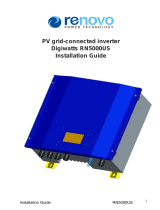
Table of Contents
SolarEdge Installation Guide – MAN-01-00057-2.2
Providing Installation Information ........................................................................................... 27
Chapter 5: User Interface ................................................................................................. 28
LCD User Buttons .............................................................................................................28
Inverter Configuration – Setup Mode ..............................................................................29
Configuring the Inverter Using the Internal LCD User Buttons ................................................ 29
Configuring the Inverter Using the External LCD Light Button ................................................ 31
Inverter Configuration Menu Options ..................................................................................... 33
Inverter Status Screens – Operational Mode ...................................................................36
Initial Inverter Status ............................................................................................................... 36
Main Inverter Status ................................................................................................................ 37
Energy Meter Status ................................................................................................................ 37
Telemetry Status ..................................................................................................................... 37
ID Status .................................................................................................................................. 37
Server Communication Status ................................................................................................. 38
IP Status .................................................................................................................................. 38
ZigBee Status ........................................................................................................................... 38
Communication Ports Status ................................................................................................... 39
Fan Health Status – Three Phase Inverters .............................................................................. 39
Power Control Status .............................................................................................................. 40
Chapter 6: Setting Up Communication .............................................................................. 41
Communication Connectors ............................................................................................41
Communication Types .....................................................................................................42
Removing the Inverter Cover ...........................................................................................42
Creating an Ethernet (LAN) Connection ...........................................................................42
Creating an RS485 Bus Connection ..................................................................................45
Creating an RS232 (UART) Connection ............................................................................48
Creating a ZigBee Connection ..........................................................................................49
Connecting a Laptop to the Inverter ................................................................................49
Verifying the Connection .................................................................................................49
Appendix A: Errors and Troubleshooting .......................................................................... 50
Troubleshooting Communication - S_OK is Not Displayed ..............................................50
Error Codes ......................................................................................................................52
Power Optimizers Troubleshooting .................................................................................57
Appendix B: Technical Specifications ................................................................................ 58
Single Phase Inverters ......................................................................................................58
Three Phase Inverters ......................................................................................................60
Inverter and Mounting Bracket Dimensions ....................................................................63
Single Phase Inverter and Mounting Bracket .......................................................................... 63
Three Phase Inverter and Mounting Bracket ........................................................................... 65
Appendix C: Safe DC ......................................................................................................... 67
Appendix D: Fan Maintenance and Replacement.............................................................. 68
Fan Maintenance .............................................................................................................68





















